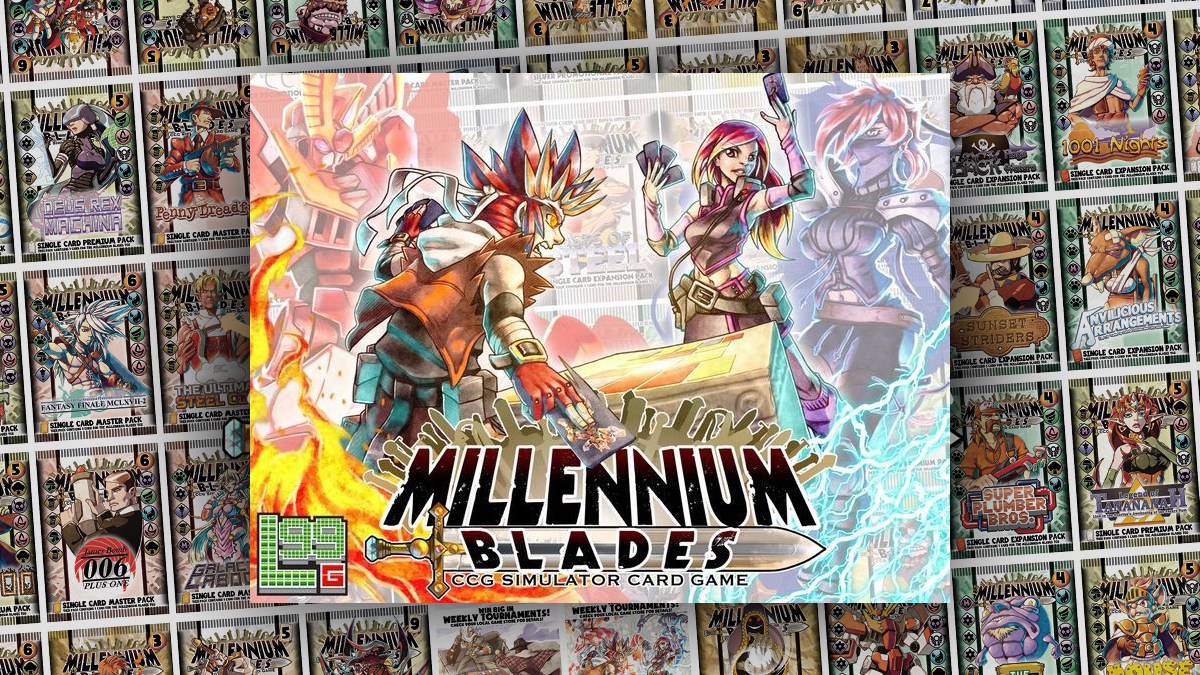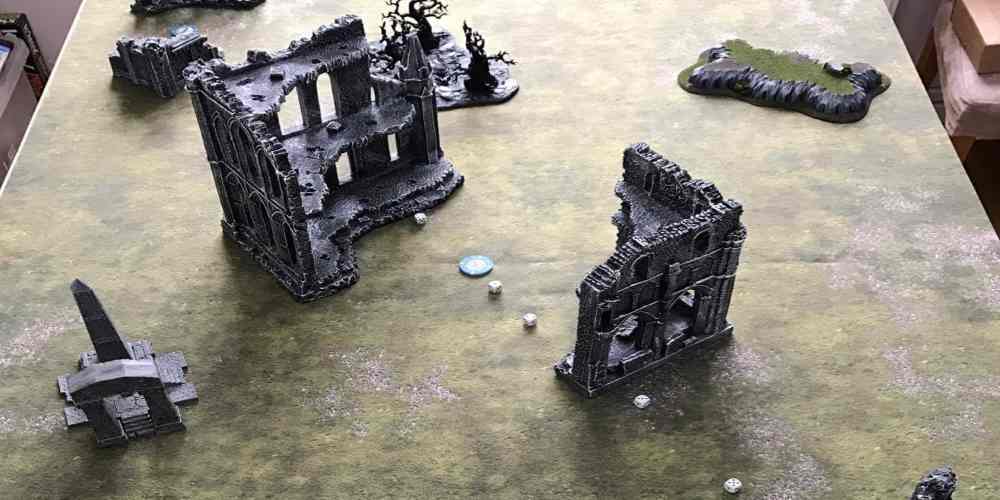What will you find in that next booster pack? Something to add to your impressive collection? Just the right card to finish off your tournament deck? Or something to sell at the aftermarket for some much-needed cash? It’s time to immerse yourself in the world of Millennium Blades.
What Is Millennium Blades?
Millennium Blades is “the world’s most popular collectible card game” and has been “in print for more than a thousand years,” with players all over the world competing in tournaments and collecting rare cards.
Millennium Blades is also a card game of the same name about this imaginary CCG for 2 to 5 players, ages 12 and up, and takes about 2 to 3 hours to play. It retails for $80 and is available directly from Level 99 Games, at game stores, and from Amazon. While the game does not require experience with CCGs to play, it may make a little more sense if you have some familiarity with CCGs. There is some PG language on some of the cards, but the primary reason for the 12-and-up rating is the complexity level and length of the game—Level 99 Games gives it a “high” intensity rating.
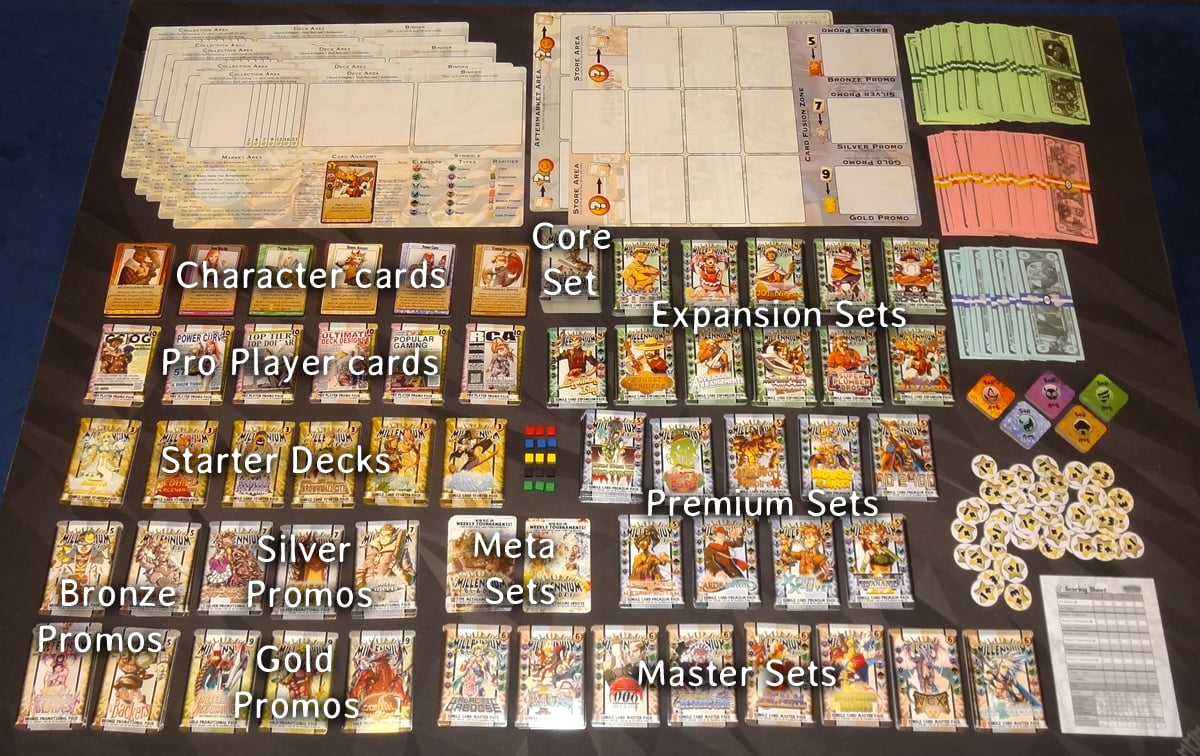
Millennium Blades Components
As you can see from the photo above, the game is primarily cards—a whole lot of cards—but there are a few other components as well.
Here’s what comes in the box:
- 5 Player mats
- Aftermarket mat
- Store mat
- 15 RP markers (3 each in 5 player colors)
- 20 Sell markers (4 each in 5 colors)
- 50 +1/+3 tokens
- 800 Millennium Dollars (with 80 currency strap stickers)
- 1 Score Pad
- 1 Core set (118 cards)
- 6 Character cards
- 36 Friendship cards (6 cards per character)
- 6 Pro Player card sets (5 cards per set)
- 6 Starter Decks (9 cards per deck)
- 4 Bronze Promo Sets (6 cards per set)
- 3 Silver Promo (6 cards per set)
- 3 Gold Promo (6 cards per set)
- 11 Expansion Sets (12 cards per set)
- 9 Premium Sets (12 cards per set)
- 8 Master Sets (12 cards per set)
- 2 Meta Sets (6 cards per set)
- 10 Venue cards (not pictured above—oops!)

Each of the deck types has its own card back, made to look like a booster pack, with a band at the bottom that says what type of card it is—starter, core, expansion, and so on. There’s a price shown at the top right, though—just like real booster packs—what you find inside may be worth more or less than what you paid. Aside from the starter decks and the core set cards, all of the cards also have icons on the card backs that give you a hint of the elements and types that are included in their sets.

There’s a vast number of different “sets” that get mixed into the deck when you play, and the game is full of references to games, movies, and other pop culture icons: Mega Man, Super Mario Brothers, Firefly, Final Fantasy, Harry Potter, James Bond … I could go on and on. I’m sure there are a ton of things that I’ve missed entirely; I’m also not as familiar with CCGs but my friends who have played Magic: The Gathering have assured me that there are plenty of allusions to other CCGs as well.

The game’s commitment to its particular aesthetic is impressive. To create the feel of handling piles of cash, the money in the game is actually bundled into units of 10 bills, wrapped with a sticker strip. And since the bills are printed only on one side of the paper, you’re supposed to take 5 bills, stack them on 5 bills turned the other way, and then wrap them with the strips, so that when you spend money during the game, you’re actually spending stacks of cash. I assembled my cash bundles while watching TV, and it took a good while to get everything put together, but I do have to admit that it is a lot of fun to use (and a lot easier than individual bills). My only complaint is that it seems strange for a bundle of $1 bills to be worth $1, and so on. I’m not sure why everything isn’t just bumped up to $10, $50, and $100 denominations instead.

The single punchsheet of cardboard includes the sell tokens and the +1/+3 tokens. The sell tokens are large square tokens—each player will receive a set of these, though the element pictured on the sell token may not actually correspond to your starting deck or player color, which can be a little confusing. All of the tokens are pretty sturdy cardboard, not exciting but perfectly functional.

The mats are large sheets of cardstock, with various spaces for cards. The player mats are double-sided and also include various player reference information, including a legend explaining all of the symbols (which is helpfully on both sides of the mat).
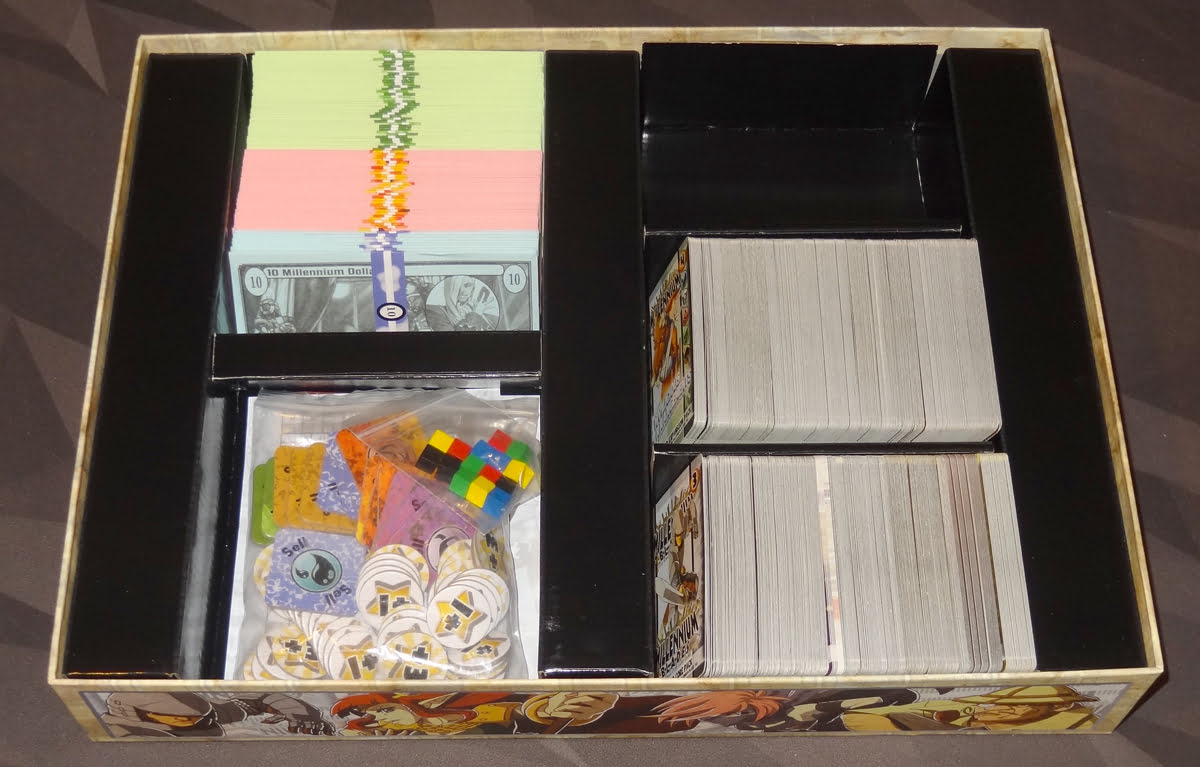
The box insert is just a cardboard affair, with three wells sized for the cards, one well that fits all the bills, and one well that holds everything else. There aren’t any card dividers to help you keep things organized, so you’ll just have to figure out your own organizational system, unfortunately.

How to Play Millennium Blades
You can download a copy of the rulebook here. The game is fairly involved, but I’ll try to give a high-level overview without too many of the little details.
The Goal
The goal of the game is to score the most points by building up valuable collections and winning tournaments.
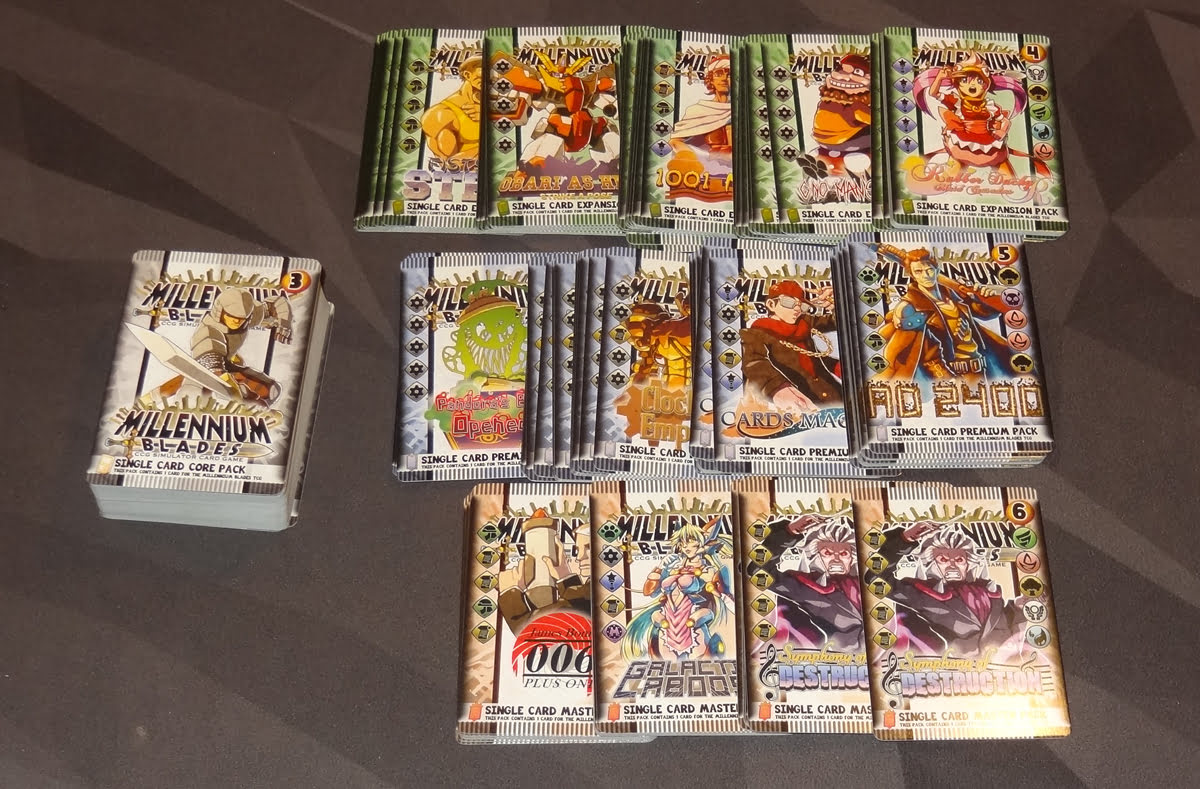
Setup
The main deck for the game is made up of a lot of cards:
- Core set
- 5 Expansion sets
- 4 Premium sets
- 3 Master sets
(In case you’re keeping track, that’s 262 cards that get shuffled into a single deck—might be time to invest in a card shuffler.)
The deck goes onto the store mat, and the top 9 cards are placed into the store spaces. In addition, you’ll choose three promo sets (bronze, silver, and gold) and place those in the promo sections on the store mat.
You also set aside an additional bronze promo set and a silver promo set for prizes used in the tournament phases.

Shuffle the two metagame sets separately, and place them in the metagame area. These will get revealed during the deck-building phase, and will award bonus points during the next tournament for a particular type and element.
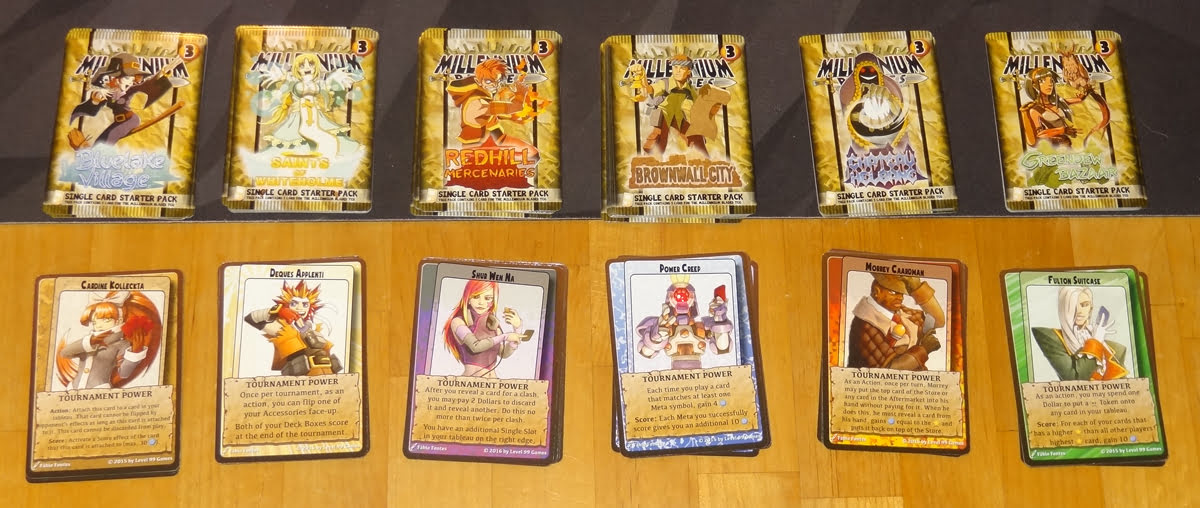
Each player gets a player board, a character (with the associated friendship cards), three wooden tracker cubes, and sell tokens. Each player also gets 3 cards at random from the top of the store deck.
Gameplay
Millennium Blades takes three rounds, each of which consists of a deck-building phase and a tournament phase. The deck-building phase is timed and everyone plays simultaneously, without a turn order. The tournament phase is not timed, and players will take turns playing cards and using actions.
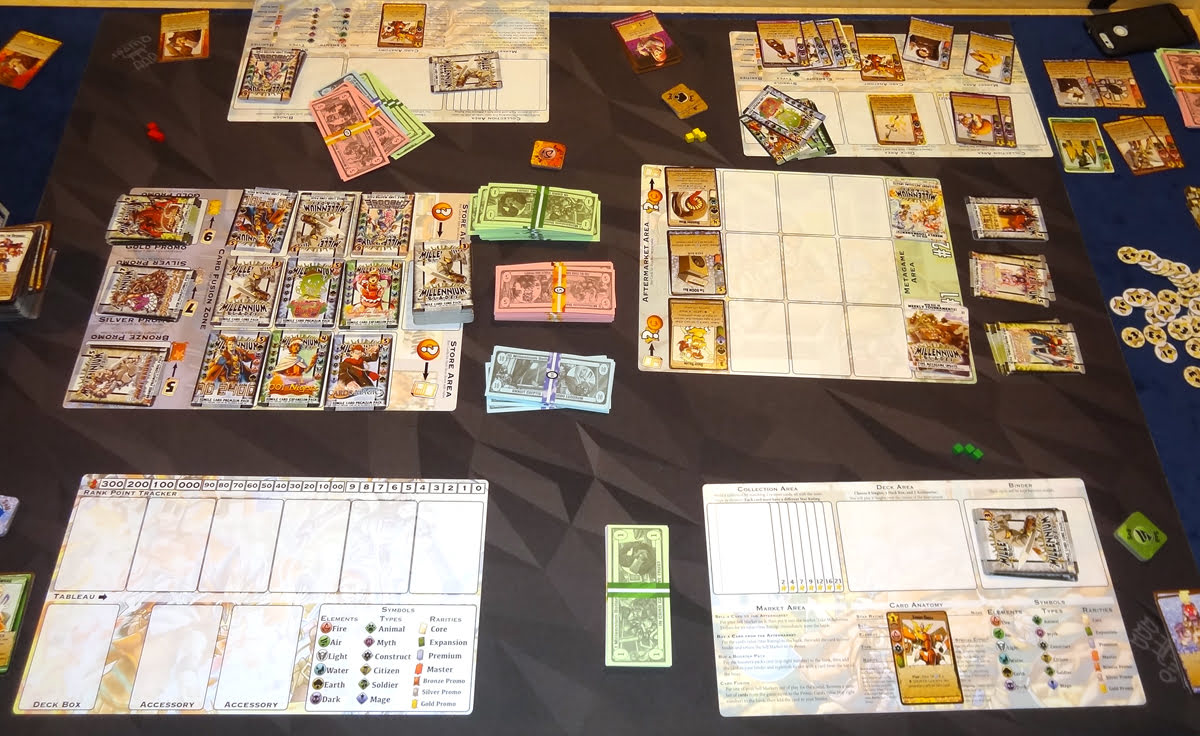
Deck-building Phase
At the start of the deck-building phase, make sure the store is filled with cards from the deck.
The deck-building phase has three timed segments, with a few events that happen in between:
- Get 6 cards and $30 cash
- Reveal elemental meta
- 7-minute segment
- Get 6 more cards
- Reveal type meta
- 7-minute segment
- Last call to sell to aftermarket
- 6-minute segment
At the beginning of the phase, everyone gets $30 (hey, universal income!) and 6 cards from the top of the deck for free—don’t look until the timer begins! The elemental meta is revealed. Then the 7-minute timer begins.
During the timed portion, players may buy cards from the store or aftermarket, sell cards to the aftermarket, fuse cards to get promo cards, trade with other players, and—most importantly—build their collections and tournament decks.

You can buy any card from the store for its sticker price, including the card at the top of the store deck, and then immediately replace the empty slot from the deck. Note that the star value of the cards may not be the same as the sticker price on the back of the card.

At the store, you may also “fuse” cards to get promo cards. You must fuse 5, 7, or 9 cards from your hand to get a bronze, silver, or gold promo card, respectively. The fused cards are removed from the game, and you take a promo card. Then place one of your sell markers on the promo deck—each player may only take one card from each promo set per deck-building phase. Promo cards tend to be a high star value, and have different uses based on the set.
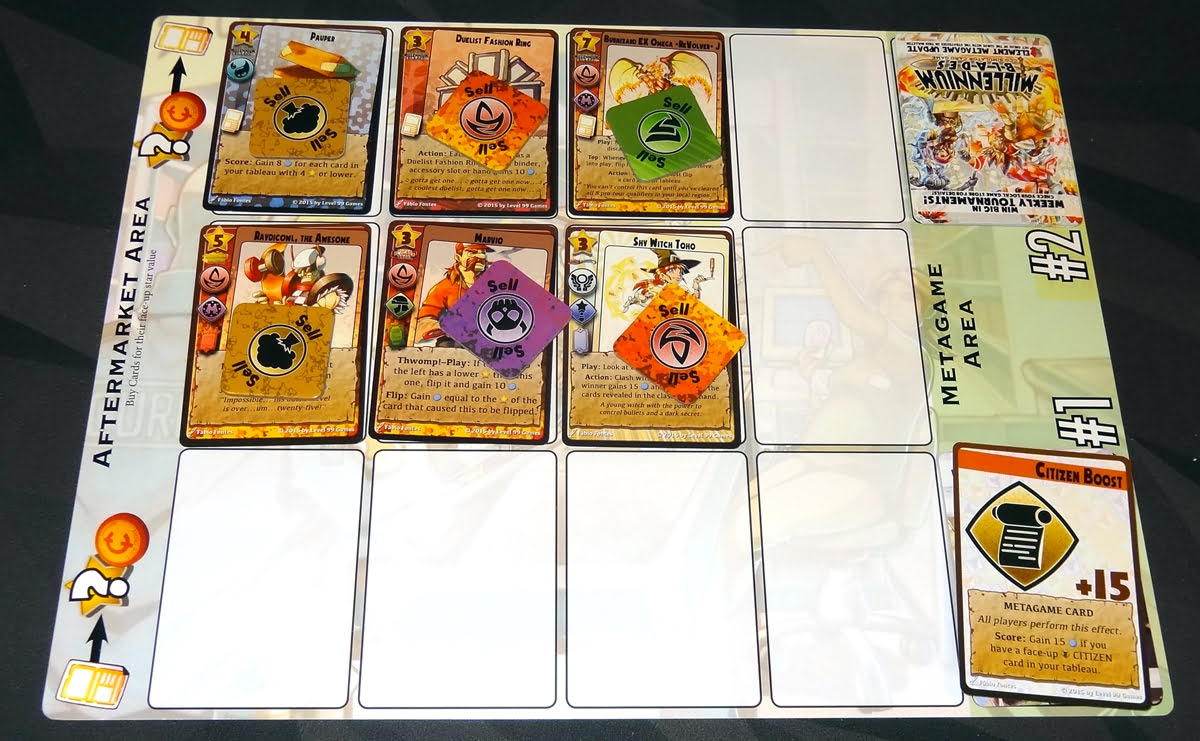
To sell a card to the aftermarket, place it face-up and get cash from the bank equal to the card’s star value (not its sticker price on the back). Place a sell token on your card. You may only sell cards to the aftermarket if you have sell tokens available. (The aftermarket won’t buy more cards from you if nobody is buying what you sell.) To purchase a card from the aftermarket, pay the star value to the bank, take the card, and then return the sell marker to its owner.

You can trade cards and cash with other players, bypassing the aftermarket, but the trades must be even. The total star values plus cash on both sides of the trade must be equal. Each player has 6 friendship cards with values ranging from 1 to 3. If you’re trying to make a trade, you can sweeten the deal by adding friendship cards. Note that these do not affect the star value of your offer; instead, the other player will earn points at the end of the game.
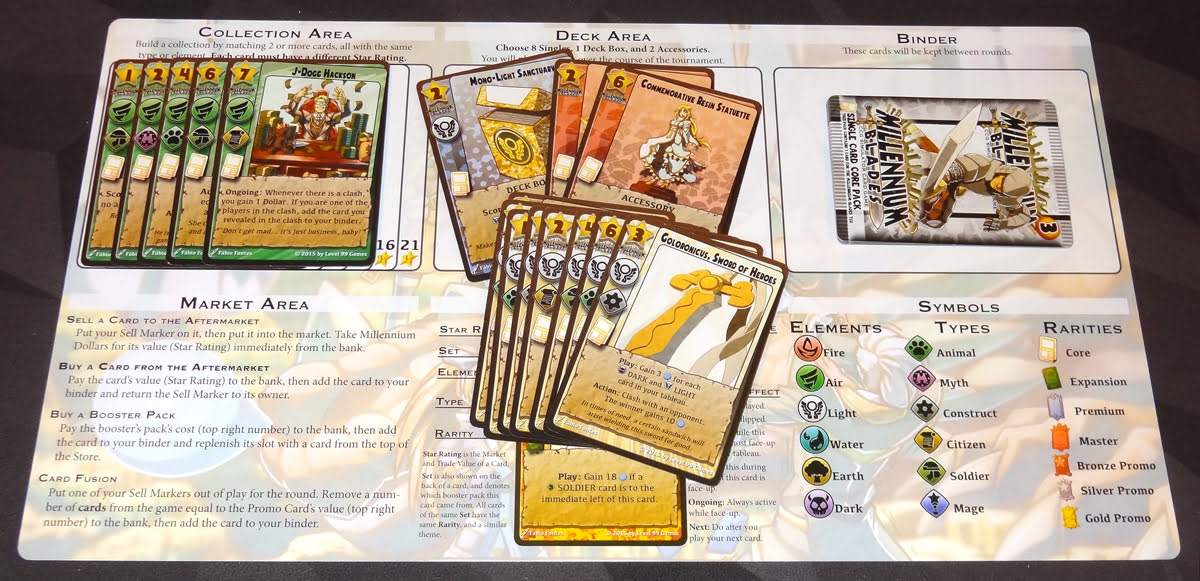
Finally, don’t forget to build your collection and your deck!
A collection consists of 2 to 8 cards, each with a different star rating. All of the cards must share either a type or an element—in the example above, all of the cards have the air element. Cards you put into your collection will score points based on the size of the collection, and then those cards will be removed from the game (because you lock them up in your safe to keep them in mint condition).

Your deck may contain up to 1 deck box, 2 accessories, and 8 unique single cards. Generally you’ll only play 6 of the 8 singles in the tournament, but having more cards gives you some flexibility in your strategy. If you put too many cards in your tournament deck, you’ll have to randomly discard cards until you are below the limits, so be careful!
During the last 6-minute portion of the deck-building phase, players may no longer sell to the aftermarket, but may still purchase from the aftermarket and do everything else. At the end of the deck-building phase, players score for their collections. All cards in the store and aftermarket are discarded, and then players flip their mats over for the tournament phase. Any cards that you didn’t put into your collection or deck will go into your binder, which is just set aside during the tournament phase.

Tournament Phase
The tournament phase simulates playing in a multi-round tournament, and players will earn ranking points (RP), tracked with the tracking markers at the top of their board. Note that these are not victory points—you will score victory points based on your placement in the tournament.
The tournament side of the player mat has space for a deck box, two accessories, and six slots in a tableau. Players should place their deck boxes and accessories face-up in the spaces, and hold their singles in their hand. The phase begins with the player who won the last tournament (or randomly in the first round) and proceeds clockwise.
On your turn, you must play a single and you may use an available action, in either order. If you cannot play a single, you also forfeit your action, and you must pass.
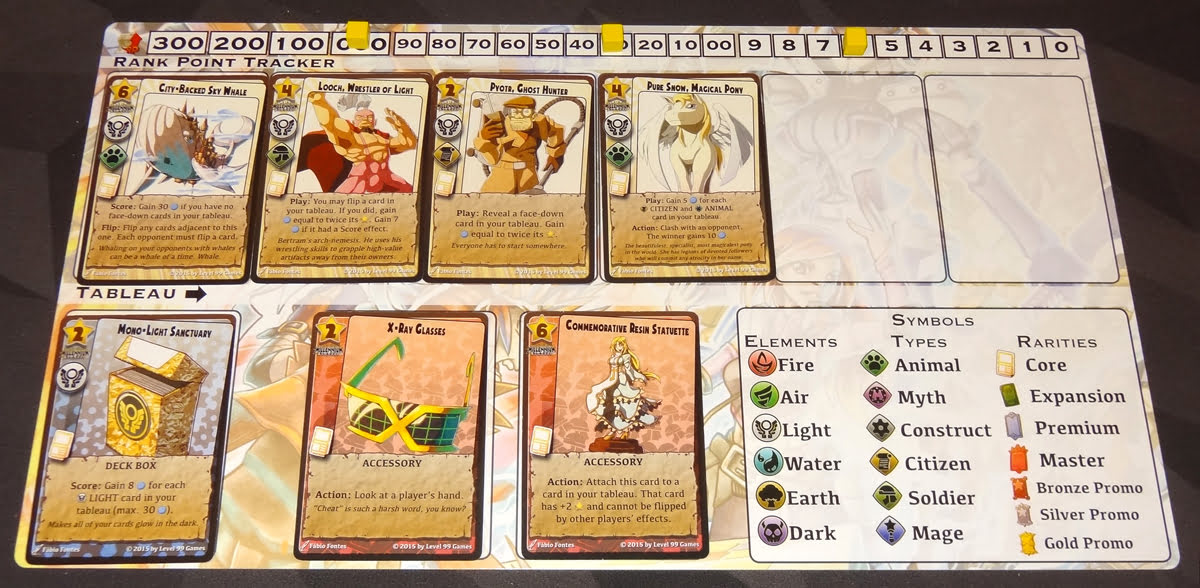
The cards have various effects on them. Play effects take place immediately when the card is played into your tableau (from left to right). Score effects are only used at the end of the tournament. Flip effects activate if a card is flipped face-down. Next effects will affect the next card you play. Some cards have actions printed on them—you may use one action on any of your face-up cards (including the deck box and accessories) during your turn. As you play cards, you may earn or lose RP, and you might flip cards—yours or your opponents—or discard cards.
One special action is called clashing: when you clash with an opponent, each player reveals the top card of the store deck, and adds its star value to the star value of their top card (the right-most face-up card in their tableau). The higher value wins; ties are just ties. The action effect will indicate what happens if you win or lose the clash. Afterward, the revealed cards are placed into the Aftermarket.

The tournament ends when all players are unable to play additional cards—typically, when everyone has filled their six tableau spaces, though there are instances where players may be able to play additional cards (or have too few cards). Then, everyone activates all of the score effects on their face-up cards, earning RP as indicated. You also score RP based on the metagame cards: if you have at least one card face-up in your tableau that matches a meta, you score 15 points (up to 30 if you match both metas).
Players score victory points based on their placement in the tournament, according to the chart. Later tournaments are worth more points than the earlier tournaments. Players will also earn a random promo card from the prize support sets. Finally, you flip the mats over and set up for another deck-building phase.
Game End
The game ends after three full rounds. Add up all of your points, plus the value of any friendship cards you’ve collected. Finally, you score 1 point for every $4. The highest score wins, with ties going to the player who won the most points from tournaments, then collections, then money, then friendship points.
Learning Game
For the learning game, the rulebook recommends ignoring character powers, and playing a shortened version. Instead of three full rounds, you will play a “pre-release” tournament using your starting decks, and then play two full rounds of deck-building and tournaments. The pre-release tournament gives you an idea of how the card play will work, so that you then have a better idea of what to look for while you’re building your deck. It does mean that everyone is playing their starter decks, which can be less exciting, but it keeps you from feeling totally lost when you’re told to start deck-building and you have no idea what the cards are going to do.

Why You Should Play Millennium Blades
When I first heard of Millennium Blades, I was immediately intrigued by the concept. A game about playing a game? Tell me more! In Millennium Blades, you don’t play a CCG—you play a character who is playing a CCG, including buying and trading cards and putting together your deck for the tournament. That one level of remove makes some people’s brains hurt, but I found that for me it just clicks.
I’ve never really gotten into any CCGs, for a number of reasons. One is simply the cost: I didn’t want to get started playing a game in which I had to keep sinking money just to compete, and that was the impression I’d always had with games like Magic: The Gathering. Searching for rare or powerful cards reminded me of when my brother collected baseball cards, opening up packs only to find that he got a bunch of stuff he already had, and then scouring flea markets looking for good trades. I just wasn’t that interested.
But the perhaps an even bigger barrier is that I’ve never really enjoyed games in which you have to build a deck (or an army, etc.) before you can start playing. Choosing what units to include is such a crucial part of the strategy … but it’s done on your own. Unless you’re drafting from a common pool, games in which you have to assemble something before playing just delay the thing I love most about playing tabletop games: the face-to-face interactions with other people. I’d rather somebody just gave me a starting army or deck and let me play. It’s why I love deck-building games, where the building the deck is part of the gameplay, rather than part of the setup.

The brilliance of Millennium Blades is that it does exactly that: it brings the deck assembling into the game itself. Now, instead of players individually spending half an hour selecting cards to put into a deck so they can play against each other, that half hour is spent together, frantically buying new cards, trading with each other, and assembling a deck. Personally, I’m a fan of real-time games (though I know plenty of people dislike the time pressure), and I love the way that this portion of the game feels, where I’m competing to build a deck at the same time as everyone else.
I’ve played with some friends who were heavily into Magic: The Gathering in the past, and one of them remarked that he was having flashbacks while playing Millennium Blades. “Gotta get just one more booster pack!”

The tournament part of the game feels a little more like a conventional card game: figuring out how to use your limited set of cards to score more points than your opponents. Depending on the style of deck you build, you might have a lot of effects that flip cards face-down, or you might have high-valued cards that will help you win clashes, or you might score points for having a lot of a particular type of element or type. The tactics available to you will depend on the particular mix of sets that created the store deck. Typically you won’t know exactly what your opponents are bringing to the tournament (because that real-time element means it’s harder to pay close attention to what everyone else is doing), so you do your best to build a deck that can score points on its own, and then you hope you can respond to whatever your opponents do during their turns.
Like a traditional CCG, though, you’re limited by your tournament deck. If you build a bad deck, it’ll be hard to win a tournament no matter the order you play your cards. You have to figure out some of the card synergies during the deck-building phase so that you have a good foundation for the tournament.
I also really love the humor in the game. As I’ve mentioned already, there are references to pop culture scattered throughout the game—whether you’ll love that or hate it is a matter of taste, of course, but that sort of thing usually tickles my funny bone. There are punny names and ridiculous accessories (like one of my daughter’s favorites, the Flippable Table).
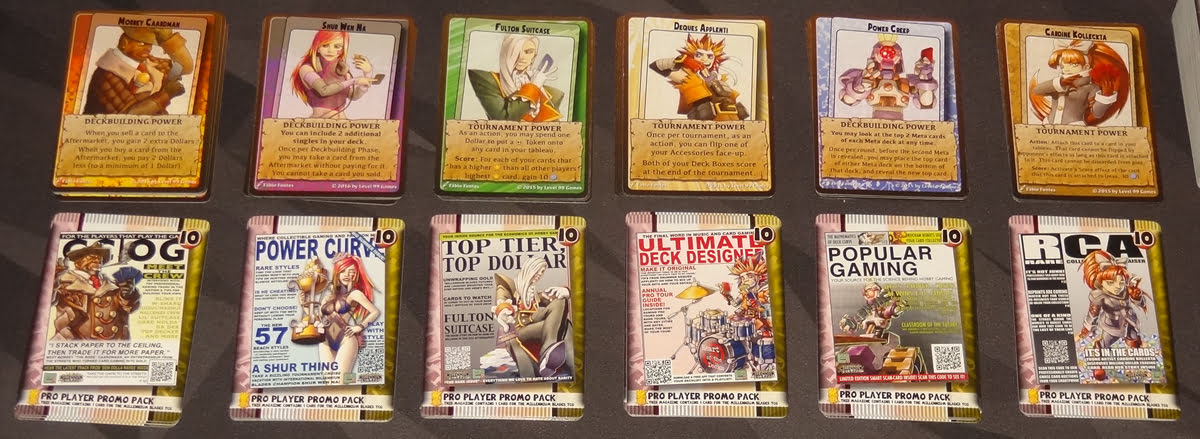
There’s also a ton of variety baked into the game. Not only can you vary the mix of cards each time you play, but you can also throw in the player powers to give each person unique abilities for the deck-building and tournament phases. Pro Player cards (which are made to look like the covers of industry magazines) are given out after a particular character wins a tournament. Each character has their own associated pro player card. If you win a tournament, everyone gets a copy of your card in their deck—the powers are related to your character power, so it introduces an interesting tweak to the game.
There are some variant modes, like a turn-based mode for those who don’t like the pressure of the real-time portion, and a duel mode for two-player games. If you’re really comfortable with the game, you can use Free Market Mode, in which trades between players do not have to be even—but experienced players will probably have a significant advantage over newer players.
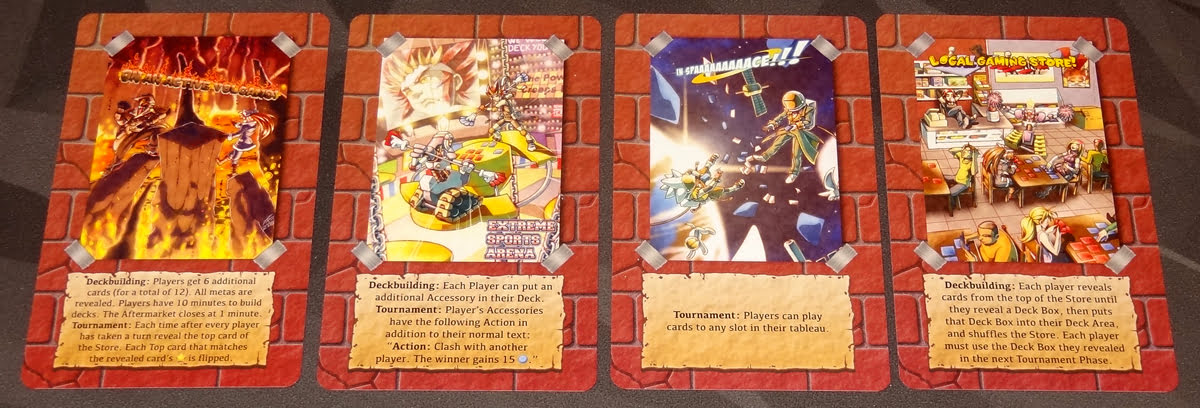
Finally, there are the wacky venues. Reveal one of these at the start of the deck-building round, and it will introduce a new rule for the tournament phase. Play a tournament while racing ostriches, or floating in spaaaaace, or at a supermarket! Most of the venues are really over-the-top. I’ll admit that I haven’t gotten to most of these variants yet myself, because typically I’ve been introducing Millennium Blades to new players, but I’ve really enjoyed even just the recommended introductory set of cards.
It probably goes without saying, but Millennium Blades isn’t for everyone. As much as I’ve enjoyed playing it, I’ve also taught some players who really disliked it, to the point where they didn’t even want to finish the second full round after a pre-release tournament. It seems like it’s a combination of factors: not grokking what you should be looking for while building a deck, frustration when you simply can’t get the cards you want for your collection, having a bad experience in a tournament where your plans are completely upended by an opponent. All of these things can give a player a bad impression, and all the more so when you’re playing a multi-hour game.
However, I’ve also played with groups who immediately wanted to play again, even after a 2.5-hour learning game. If the fast-paced deck-building phase pulls you in, then that half hour will fly by. It’s definitely a game that I’d only recommend for those wanting a unique, thematically rich experience, and I think it’s safe to say that I haven’t played anything quite like Millennium Blades before.
There are a bunch of mini-expansions and one full expansion for Millennium Blades already. I feel like I’ve only just scratched the surface of the base game so far, but I’m definitely intrigued and hope I’ll get to try the others eventually! For more information, visit the Level 99 Games website.
Click here to see all our tabletop game reviews.
If you’d like to stay up-to-date with all of our tabletop gaming coverage, please copy this link and add it to your RSS reader.
Disclosure: GeekDad received a copy of this game for review purposes.
